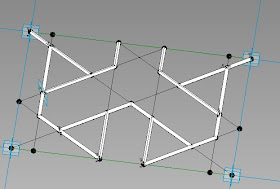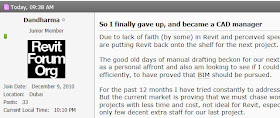George Formby ".. the frowsy night club queen." Things are not always what they seem. I thought this was a view range problem. Then I thought it was behaviour hard-wired into window families. Then I figured it out. There's probably a post about this somewhere on Steve Stafford's blog. It falls into his category of inconsistent behaviours.
I have a lot of new users at present & have been setting up window families that they can edit themselves, basically non-parametric. They are based on extrusions drawn in an elevation view. Easy to create all kinds of glazing patterns as fixed-size windows.
Today we needed to add doors to some of the ground floor openings, so I did a demo on this and it all went fine. Later on I decided to make a parametric version & as I was flexing it the transom over the doorway came into view on plan.
I experimented with view range: no joy. Seemed like the only thing that mattered was whether the offending geometry was 2400 above the host level. Spent some time charging down this blind alley & figuring out solutions based on visibility settings. (hide in plan view, etc) Then I found another family that was exempt from this problem. For a moment I thought it might be something to do with sweeps and extrusions. So I set up a little trial based on a new blank file and a new blank window family.
Once again odd behaviour cropped up, but the values were different. Now the family was fixated on a 1m cut plane regardless of what I did in the project. Bells began to ring. I've met this before. Cutting behaviour depends on the view range in the family, not the project. Checked it out and bingo. My first problem family had a cut plane set to 2400 and the second was set to 1000. I suppose this is sometimes useful, but it can also be very confusing.
Just for a laugh I opened up various wall-based templates. Surprise, surprise ... lots of little differences. Maybe there are good reasons, maybe it's just like our office content library ... work in progress, don't find time to make everything perfectly consistent. Windows have a default cut plane of 1000, projects and most other categories 1200. I haven't checked the imperial stuff. Top of primary range also varies quite a bit. What does the top range in the family actually do I wonder ?
I do believe that more consistency would be very good, but I'm not sure it will be easy to come by. I try very hard with my own work, but sadly I seem to be a human being. Maybe I'll figure it all out one day.
I have a lot of new users at present & have been setting up window families that they can edit themselves, basically non-parametric. They are based on extrusions drawn in an elevation view. Easy to create all kinds of glazing patterns as fixed-size windows.
Today we needed to add doors to some of the ground floor openings, so I did a demo on this and it all went fine. Later on I decided to make a parametric version & as I was flexing it the transom over the doorway came into view on plan.
I experimented with view range: no joy. Seemed like the only thing that mattered was whether the offending geometry was 2400 above the host level. Spent some time charging down this blind alley & figuring out solutions based on visibility settings. (hide in plan view, etc) Then I found another family that was exempt from this problem. For a moment I thought it might be something to do with sweeps and extrusions. So I set up a little trial based on a new blank file and a new blank window family.
Once again odd behaviour cropped up, but the values were different. Now the family was fixated on a 1m cut plane regardless of what I did in the project. Bells began to ring. I've met this before. Cutting behaviour depends on the view range in the family, not the project. Checked it out and bingo. My first problem family had a cut plane set to 2400 and the second was set to 1000. I suppose this is sometimes useful, but it can also be very confusing.
Just for a laugh I opened up various wall-based templates. Surprise, surprise ... lots of little differences. Maybe there are good reasons, maybe it's just like our office content library ... work in progress, don't find time to make everything perfectly consistent. Windows have a default cut plane of 1000, projects and most other categories 1200. I haven't checked the imperial stuff. Top of primary range also varies quite a bit. What does the top range in the family actually do I wonder ?
I do believe that more consistency would be very good, but I'm not sure it will be easy to come by. I try very hard with my own work, but sadly I seem to be a human being. Maybe I'll figure it all out one day.










































